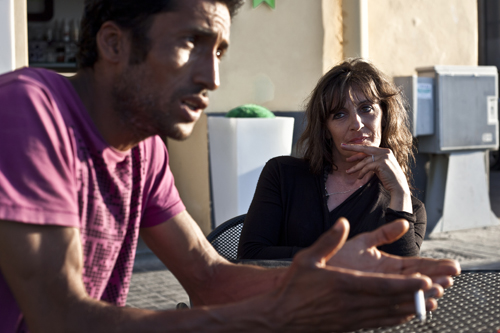Gabriele Del Grande's blog. Six years of travelling around the Mediterranean along the borders of Europe. In search of the stories that make history. The history that will be studied by our children who will read on the school text books that in 21st century thousands died at sea around Italy and thousands were arrested and deported from our cities. Whilst everybody pretended not to see. At least 19,144 people have died since 1988 along the european borders. Here are the proofs. Below you can find our reportages.
La vita che non CIE. A film on Italian identification and expulsion centres
Love in the Time of Frontier
Luck will save me
Daddy's not coming back
In the name of the Italian people
Lampedusa’s Spoon River
I returned from Tunis with thirty photographs. Pictures of young men. Some in colour, some black and white. I keep them stored in an envelope inside a notebook. Wrapped in a sheet of paper in which a list of names and dates of birth are written in pen, in Arabic. Every time I look at them I feel uneasy. As if I were afraid to meet their lively gaze now that their lives are gone. Yes, because those thirty young men are some of among at least 187 Tunisians lost at sea in 2011 en route to Lampedusa
Riad’s watch and they young men of Ouardiya
Ahmed, Akram, Mohammed, Makram and Walid
The Nasri cousins and the Aayari family
Walid, a Paduan among the dispersed of Sidi Mansour
The sinking of Zarzis and the young men of Jebal Ahmer
The Boulila brothers and the young men of Hay Nur and Mallasin
The sinking of Sfax and then4 martyrs of the Cherni family
Lampedusa rap. Music and Harraga Special
Love in the time of frontiers
She is smirking and enjoying sending kisses in the direction of the policemen at the gate of the centre for identification and expulsion of Chinisia, Sicily. Some look on with suspicion to see whom that sudden and inappropriate attention is dedicated to. But it’s not to the men in uniform that Sakina is looking at. The kisses are for the man behind the bars, the Tunisian wearing a purple shirt, whose hands are gripping the bars of the cage and who mouths to her "je t'aime"...
Three young couples and one border which makes their love impossible.
Love in the time of frontiers. Sakina and Khayri
Love in the time of frontiers. Winny and Nizar
Love in the time of frontiers. Nathalie and Salah
The European court condemns Italy over rejections to Libya
Guantanamo Libya: the new Italian border police
Border Sahara: the detention centres in the Libyan desert
Libya: reportage from the detention centre of Misratah
Revolutionaries and racists? Africans in Libya after the end of the regime
Tripoli is still in shock after the blood shed during the fighting for its liberation. In the city the search for Gaddafi’s mercenaries continues. And black skin continues to be seen as a first indication of guilt. Yet in the city the announced massacre has not take place. However hundreds of Africans have been arrested and others are still stranded in the port of Sidi Bilel, which used to be the main departing point for the boats heading to Lampedusa. The sea crossing were organized by the militias of the regime. We have reported it many times. And now we also have a video which confirm it
Revolutionaries and racists? Who is saved and who is not
Sidi Bilel: this is where they use to leave for Lampedusa
A video shows Gaddafi’s role in the landings in Lampedusa
The CIE’s Arab Spring: 580 escapes in 2011
Hunger strikes, self-harm, arson, escapes and out-and-out riots. The rebels are the thousands of young Tunisian men who landed in Lampedusa and ended up in the Italian Centres for Identification and Expulsion (CIEs). With the bodies with which they crossed the sea they are now trying to jump over the cages where they have been locked up, risking a trip to hospital with broken bones from beatings, or to prison on charges of assaulting a public official
And now everyone inside CIEs! How to get a press pass
It’s the end of censorship. The new Interior Minister Maria Cancellieri has reopened the doors of the centres for identification and expulsion (CIEs) to the press. Many of you have asked us how to untangle the bureaucracy of the Prefectures to obtain the pass. Today we explain everything. And we invite all journalists who read this blog to follow the procedure. So that each week stories may come to light, breaking the wall of silence while we wait for other walls to come down
Circular 1305 withdrawn. The press returns to the CIEs
Let us enter in the CIE! The appeal of the journalists
The war of Lampedusa
The Italian border is out of control. With no law and no information. Entrusted to teams of hotheaded thugs. The same officers responsible for the tortures of 2001 in Genoa, for the continuous suspicious deaths while in custody of police stations, and for the increasingly frequent beatings in the centres for identification and expulsion (CIEs). Supported also by the employees of ‘Lampedusa Accoglienza’ (the Lampedusa reception team) who have been seen holding iron bars to beat the Tunisians after the riot. Witnesses are few. We asked them to tell us what really happen in Lampedusa the 21st of September. This is their count
The war of Lampedusa told by Alessio Genovese
Lampedusa was already burning. Letter from Marta Bellingreri
They covered everything up. Evidence of regime in Lampedusa
We are the gray area
Free Ismael! The sit-in of the Peruvians outside the Cie in Turin
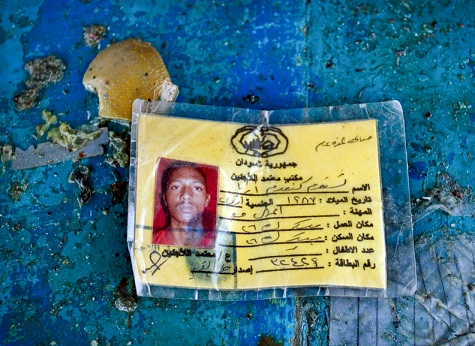 | The refugees from Libya and the factory of illegality The Italian factory of illegallity will generate an income of 400 million Euros in 2011 in a variegated world of associations, cooperatives and small hotel owners. Forcing an estimated 15 to 20 thousand people to live in hiding from one day to the next, after having been cared for in every respect by the State. We are talking about the African refugees escaped from the war in Libya The invasion that is not there. From Libya 23,890 refugees | |||
 | Great escape on Christmas Day in the CIE of Turin Christmas-time is holiday for everyone. For the blacksmiths, who were supposed to repair the damaged locks of the cage. For the police on duty, who surely must have the right to uncork a bottle of sparkling wine. And especially for the inmates of the deportation centre of Turin, who on the evening of December 25 instead of waiting for their presents, proceeded to break through the gates of the cages and escaped. Revolt in the CIE of Turin: 3 injured, tension still high More self-harm in the CIE of Milo. Escape in Vulpitta | |||
 | Tunisia: the repatriation limbo In Tunis it is October 20, the country is preparing for the elections. At 7 am the streets are already full of commuters and workers. The mini-bus station Mansuf Bay is full of people coming and going from all over the country. I heard someone call out to me from the crowd. It’s Karim, one of the 1,300 Tunisians who were in Lampedusa during the riots. 3,592 Tunisians expelled, will peace return to the CIEs? | |||
 | Italy: floating CIEs After the tent cities, the ships. Three ferries in the port of Palermo, in Sicily, used as a centre for identification and expulsion. Inside, hundreds of young people are locked up. Deprived of their liberty for weeks, without validation of the court and without any legal assistance. An illegal procedure which make the Palermo prosecutor open an investigation for illegal detention Floating CIEs: the straps Floating CIEs: after the exposé, an investigation begins | |||
 | Samhini yamma. Will Amir's mother understand? The train to Bologna is leaving from platform 10. From behind the window, Mahmoud puts in his earphones and hits play on his iPhone. Samhini yamma by Ashref. Samhini yamma, forgive me mother. Waving goodbye from the platform is a young man, eyes reddened by tears. It is his best friend. They grew up together in the streets of Sfax, Tunisia and together they made the crossing to Lampedusa | |||
 | What will become of the refugees from the war in Libya? Anger is brewing among the thousands of people who have arrived in Italy fleeing from a country at war. Parked in mega centers and left alone, after seeing the first denials of their applications for international protection, they realize for the first time that in Italy they will have no chance. What is going to happen now to them? | |||
 | The invasion that is not there. From Libya 23,890 refugees Since the beginning of the year 23,890 people from Libya disembarked in Lampedusa and in Sicily, in other words 65% of those who arrived throughout 2008. And the pace of arrivals is in sharp decline. In the second half of July, for example, there were no landings for over two weeks | |||
 | In the Strait of Sicily at least 5,962 deaths since 1994 The year 2011 is the worst. So far this year, among the dead and missing, at least 1,674 people have disappeared in the Strait of Sicily, 239 deaths per month, 8 per day: a massacre. The data was last updated August 1, 2011. It does not take into account all the ghost shipwrecks, of which we will never know a thing | |||
 | Successful evasion in the CIE of Rome, Italy Jamal still feels pain in his shoulders. He jumped from the wall and landed badly. But he jumped. And now he's out. Free at last. Ready to return to his girlfriend’s arms in Bologna. He fled last night from the centre for identification and expulsion (CIE) in Rome. And along with him another 30 detainees escaped | |||
 | From war to the CIE. Walid, an Algerian in Italy Boubacar has realized this over time. That heaven does not exist. And that ties, by dint of being pulled, get broken. And in the last few days he has repeated this ad nauseam to his new cellmate. His name is Walid, he too is Algerian, but he is only 21. The more Boubacar looks at him, the more he feels like he’s looking at himself at the beginning of his Italian adventure | |||
 | It's the law: 18 months in the Italian centres for expulsion The Italian Senate has now passed into law the repatriation decree. The maximum limit of detention in the Centres for Identification and Expulsion (CIE) has thus increased from 6 to 18 months. Within the CIEs, inmates have received the news with much anguish. Nobody can explain how one can justify spending 18 months behind bars for a journey without a passport | |||
 | CIE in Rome: 20 stitches to avoid expulsion Someone tell us if this is normal. If to visit his sister in Livorno, on the eastern coast of Italy, a boy of twenty should open his thigh with an iron razor blade and dig into the meat until the cut runs deep, because only by doing so he will not be sent back to Tunisia | |||
 | Ponte Galeria, Italy: Work will set you free The first to be deported were the 17 Egyptians loaded onto a plane to Cairo. Their absence will be felt. They will be missed by their families in Rome and by their employers. Yes, because apart from a young man from Mansura, all the others worked as porters in the food central market of Rome | |||
 | Play-by-play of the revolt in the CIE of Rome It's just past midnight at the Center for Identification and Expulsion (CIE) in Rome, Italy. Three convicts try to escape. The police find them and cruelly beat them. Someone witnesses the scene, however. And outraged, spreads the word among the inmates of the men’s area. And the revolt breaks out | |||
 | Ramzi who spent 14 months of the last 2 years in a CIE How long ago the summer of 1996 seems. And that holiday spent cruising the Mediterranean. Ramzi was twenty. From Tunis they left in seven. University students, middle class, no desire to ‘burn the border’ and get into trouble with customs. A few adventures with the girls on board was a more than tempting program. But instead... | |||
 | Daddy hung himself at the CIE of Milan In a small town in Italy, a little five-year-old girl has lost her desire to play. Because Dad is gone. Every now and then she talks to him on the telephone but he never comes home. Only last time he said he was arriving. That night, however, they found him hanging from a rope in the Center for Identification and Expulsion (CIE) in Milan | |||
 | Italy: guards that beat women in the CIE Look at these photos. They were taken in the Centre for Identification and Expulsion (CIE) of Rome. You can see a young Tunisian detainee with evident bruises and signs of beating by truncheons on her back and her arm. As she herself recounts. It is not the first time. In Milan something similar happened two years ago. No truncheons. The violence was of another type: sexual | |||
 | Rivotril, suicides and revolts in the CIE of Milano A crack in the wall of silence, which has been surrounding the Centre for Identification and Expulsion (CIE) of Milano for over a year, seems to be opening. Someone came out and spoke out. The story of yet another father, raised in Italy and marked by a criminal record. The desperate acts of three Tunisians who attempted suicide and of 7 men who lit fire in sign of protest | |||
 | Sellotape, injections, razorblades and deportations The tape is used to immobilize the prisoners. And when they scream, to cover the mouth as well. The injection is for the women, because they too misbehave sometimes, but one must be a gentleman... While the razorblades are used by the men and women. You either slit your writs or you swallow them. Once again stories of torture and violence from the Italian deportation centre of Rome | |||
 | Guantanamo Trapani. We entered the Cie of Chinisia From far away it looks like a Lego construction, but close-up it is nothing more than an improvised perimeter fence of yet another cage, perhaps the worse in this Italy, so inhospitable and ferocious with the most unwanted of travellers: the harraga. We are in front of the new deportation centre (Cie) of Chinisia. No journalist is allowed to enter. But we decided to try anyway | |||
 | Frontex, how much are you costing me? Three hudred thousand Euros to repatriate 21 Burundi nationals. Four hundred thousand for 56 Iraqis and an astounding half million for 60 Nigerians. The expulsion machine in Europe does not seem to know about crisis. At least, judging from the last annual report by Frontex, the EU's agency for the patrol of the external borders, which in one year managed to spend 8,525,782 Euros to repatriate 2,038 people | |||
 | Let us enter in the CIE! The appeal of the journalists There is a return to censorship in Italy. Since the 1st April the journalists are banned from entering in to the centres of identification and expulsion (CIE) and the reception centres for asylum seekers CIE: new government, same old censorship Empty promises. CIEs still under censorship Italian journalists ask a Court to remove restrictions to the exercise of freedom of information over the CIE Detention centers: Italian journalists write to Maroni How Italy expelled journalists from the deportation centres | |||
| Guantanamo Italy. Images from the CIE in Palazzo A video shot with mobile phones by the detainees themselves, who then handed it to a journalists, shows for the first time the evidence of police beatings and of the attempts to escape. And the images of the Guantanamo of Palazzo, a small village in the region of Basilicata. | ||||
| The cie of Santa Maria is on fire and it is impounded One less. The centre of identification and expulsion of Santa Maria Capua Vetere, in the province of Caserta, no longer exists. It was destroyed by the flames of the fire that blazed up last night. The Public Prosecutor asked for its probationary impoundment, arranging also for the transferral of the detainees | ||||
 | Libya: 1400 deaths since the beginning of 2011 It’s been twenty years now since the Sicilian Channel has been crossed by the boats of those who travel without a passport towards the northern shores of the Mediterranean. But something like this has never been seen before. Since the beginning of this year, there are at least 1.408 names missing | |||
 | Kidnapped by the State in Lampedusa Two hundred Tunisians are being held hostage by the State for over a month now. There are two lawyers who are trying to defend them but they come up against the obstructionism of the Ministry of the Interior with the result that the right to legal defence is being denied to a former prisoner of Ben Ali’s regime An Italian judge: false imprisonments in Lampedusa Lampedusa: 28 attempt suicides against repatriations | |||
 | Lampedusa: Winny’s husband beaten by the police His story touched many Italians some weeks ago, when his wife Winny, a 23 year old Dutch lady, came to Lampedusa to take her 29 year old husband back. But now the dream of their love story turned into a nightmare. Nizar was beaten up by the police at the reception centre of Lampedusa, and was then arrested | |||
 | Forced deportations to Lampedusa. A Gaddafi's reprisal for the bombardments? They are arrested in the African neighbourhoods of Tripoli by Gaddafi’s soldiers and forced to embark for Lampedusa. The ticket is on the house, provided by the regime. Definitely not voyages of hope, the crossings of the Mediterranean look more like actual mass deportations of Africans from Libya. Systematically organized by the army of the dictatorship, in reprisal for the Nato's bombardments | |||
 | Revolutionaries and racists? The rebels’ massacres We already know the crimes committed by Gaddafi’s troops. But nobody wants to talk about the crimes perpetrated by the rebels. Maybe because the rebels’ racism is a taboo too big to face. Or perhaps because the correspondents in Benghazi were not able to notice anything in person, since they were on the wrong side of the front to do it | |||
 | Tareq´s birthday On 15 March, Tareq turns five. And he’s really hoping that for his birthday daddy will come home. He’s not seen him for two months now. No one has told him what has really happened yet. How do you explain to a child that a law in Italy prohibits a father from living with his own son if he does not have a paper called ‘residency permit’? They have expelled Tareq´s father | |||
 | Free like the wind. The borders of modernity called Ventimiglia In 2011 mobility is an unavoidable part of the dimension of modernity. There is no need to be a labourer or a refugee in order to move from one side of the world to the other. It’s sufficient to be children of our times to feel the need to leave and become someone different. To recognize that, is to recognize that there aren’t civilised people nor barbaric people | |||
 | Caught in the crossfire. Foreigners in Libya during the revolution Nashat didn’t have the time to pack his luggage when he escaped.He only managed to take the photograph of his children. He asks me to show it on television so that his family in Banisuif, in Egypt, may know that he’s still alive. A crowd forms around him. They are all Egyptians and they are thousands, all stranded in the industrial harbour of Misratah | |||
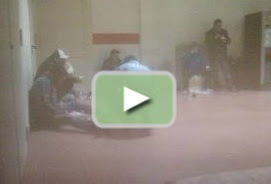 | Tunisians’ revolt at the Italian deportation centres After two days of riots, the deportation centre of Gradisca is literally out of service. There’s only one cell left for 100 detainees, and many are forced to eat and sleep rough on the floor, cramped in the corridors and in the dining hall, where they are all locked up the entire day. Today we are able to show you the exclusive images of this degradation Turin: hunger strike at the detention centre On facebook the Tunisians’ protest from the Cie of Turin Freedom is the most beautiful thing in the world Noureddine Adnane. A martyr in Palermo | |||
 | Tunisians remember victims of perilous journey to Europe A reportage of Neil Curry broadcasted by the Cnn. Curry went in the city of Sedouikech and there he met the families' member of a group of 30 Tunians died after a ship of the Tunisian Navy hit a migrants' boat on its route to Lampedusa | |||
 | Waiting for Paris. Journey to Lampedusa with the Tunisians The Meridiana’s flight for Palermo has taken off on time at 12,30. Amongst today’s passengers there’s also Fouad Ben Maguer. He’s one of the Tunisians who arrived on the island these days. But unlike all the others he has come from Paris. What brought him here is the frail hope that his brother may have saved himself The Tunisians’ journey: Lampedusa, the first flight The Tunisians’ journey: from Bari looking for adventure | |||
 | Italy which deports ‘Italians’ The victims of the crackdown on the so called illegal immigration are mostly ‘Italians’. They do not have citizenship, but they’ve been living in Italy for the past twenty years. Their families are waiting for them on the outside of the deportation centres, hoping they will not be expelled. Here are their stories In Turin he has a wife and a baby. But he´ll be repatriated Floriana, in Italy since she was 13, deported to Albania In Italy for the past 29 years, with his family. Now in a CIE From the mansions of the rich to the CIE of Rome Birthday party in the CIE of Rome. But the girl is 16! Expelled with children in Italy: two stories from Milan Stateless Croatian, Italy insists on his deportation Edward and the ping-pong game between Italy and Ghana CIE in Turin: a soldier shatters his tooth, he files a report Supreme Court: expelled even those with children in Italy | |||
 | Libya: pushed back migrants speak out from the Sahara We reached them by phone. They are 38 Somalis, detained in a prison situated in the middle of the Libyan desert, a thousand kilometres south of Tripoli, where they have ended up after having been pushed back to Libya on the 30th August Do they know? JRS Malta releases a new report on Libya | |||
 | The evidence of tortures against refugees in Libya We got the pictures of 50 Somalis stabbed with knives by the Libyan police, after a riot in a detention centre near Benghazi. Libyan ambassador in Mogadishu, Rabiic Canshuur, denied the report. This time, it will be a bit more difficult to deny these photos | |||
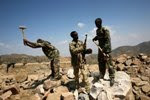 | Forced labour and tortures for repatriated Eritreans Exclusive: three witnesses speak out. Caught by the Libyan police on the route to Lampedusa, they were repatriated in 2004 on a flight paied by Italy. And the same could happen to the Eritreans deported from Italy to Libya in these days VIDEO Eritrea: voices of torture Eritrea: hopes betrayed by the regime repression Service for life: the Infinite Conscription in Eritrea Refoulement: 1.409 migrants pushed back to Libya Letters from the Eritreans in Tripoli | |||
 | The Northern Jungle. Reportage from Calais and London A documentary by Vincent Nguyen and Jean-Sebastien Desbordes. With the voices of the Eritrean refugees, the truck drivers, the smugglers, and the social workers
| |||
 | Libya: externalize the borders to externalize asylum? While more than 1.000 migrants have been deported to Libya from the Italian patrols, Tripoli is considering to sign the Geneva Convention. The first step to the externalization of asylum. Mass deportations and some resettlements to appease the EU coscience | |||
 | The massacre: 459 deaths in the first 6 months of 2009 The number of deaths at the border fell for the first time over the last three years. In the first semester of 2008, the victims were 985. The main reason is the objective decrease in the number of arrivals, particularly in Italy and Spain | |||
 | 74 Eritrean Refugees Sent Back to Libya on 1stJuly We received an appeal from the Eritrean community in Tripoli. The passengers of the vessel which was denied entrance off the coast of Lampedusa, were Eritrean: Eritrean refugees who now risk being repatriated or held indeterminately in Libyan prisons | |||
 | Sent back to Libya: Exclusive Photos from Paris Match There were two French journalists, aboard the Italian Coastguard patrol boat which returned 90 migrants rescued from the high seas to Tripoli on 13th May, 2009. Here are their exclusive photos which show the conditions of the deportation | |||
 | Lampedusa: Tunisians beaten by the Italian police On 18th February 2009, a riot broke out leaded by the Tunisians detainees after one month of detention in inhuman conditions. The Italian police answered back by beating tens of inmates. Today we are able to make you listen to the voices of the witnesses of that violence | |||
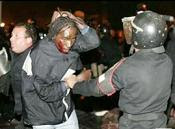 | Egypt: on the route of the Eritrean diaspora to Israel Asmara, Cairo, Tripoli, Asmara. Father Austin glances through a dozen white envelopes. He checks the addresses written in pen. There are no stamps. These are the letters of Eritrean prisoners of Burg el Arab. They were arrested in Egypt on their way to the Jewish State | |||
 | Brave Captains. Lampedusa's fishermen talk "We are in the same area. It is our fishing zone, and they pass through it". Almost every day, Sicilian fishermen cross the migrants' boats on their route to Lampedusa. And often they rescue them. Last time it happened on 28th November 2008. With a stormy sea and waves eight meters high | |||
 | Guantanamo Libya: the new Italian border police The iron door is closed. From the small loophole I see the faces of two African guys and one Egyptian. I can't stand the acrid smell coming from the holding cells. I ask them to move. Now I can see the whole room, three meters per eight. There are about thirty people inside | |||
 | Israel: the new route for Eritreans refugees Instead of the Libyan prisons and the death in the sea they prefer the Jewish state. In 2007, according to the UNHCR, about 5,000 asylum seekers entered Israel. Meanwhile, Egypt reinforced its control devices, allowing the border police to open fire on the migrants | |||
 | Trapped in Greece: illegal entry, illegal exit Every time I enter the sea, I feel anguish. And I think it is not normal. I walk with caution, in a small bay of the Greek island of Samos, full of tourists. I don’t wear shoes. And I'm afraid to touch a dead body underwater. I have in mind the pictures I saw one week ago in Lesvos | |||
 | Patras: ECHR admitted the case of 35 refugees Border Sahara: the detention centres in the Libyan desert Libya: reportage from the detention centre of Misratah Tunisia: the dictatorship south of Lampedusa Lifes in limbo. Migrants and refugees in Cyprus Istanbul on the way of African migrations The situation of exiles on the English Channel Egypt: Deadly journeys through the desert Held in Ukraine, immigrants cling to Europe dream |


